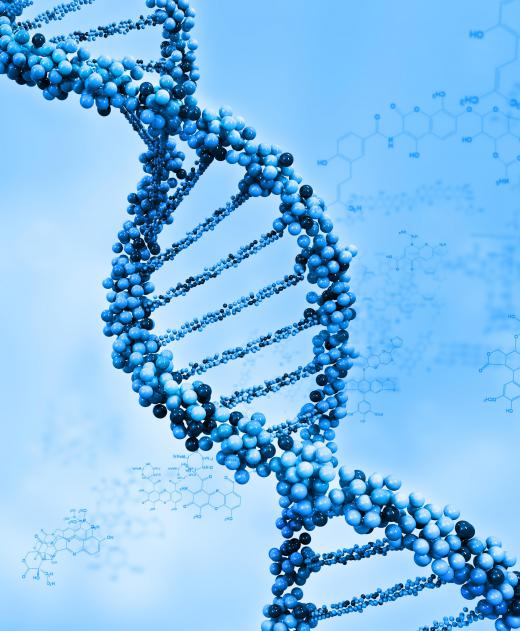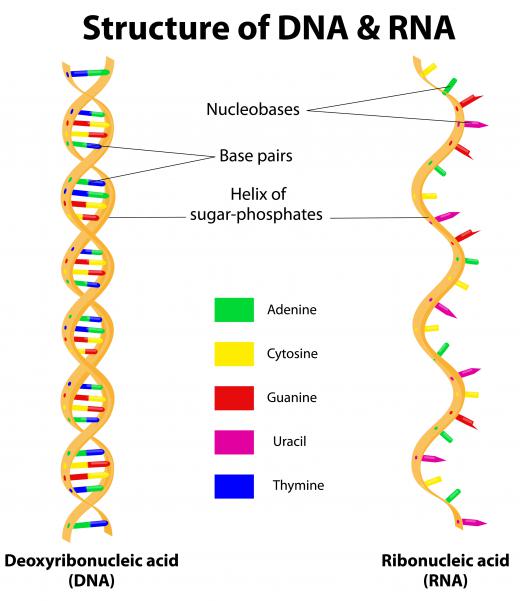What is a Reading Frame?
 Mary McMahon
Mary McMahon
A reading frame is a sequence of genetic information which contains data which can be used to code amino acids which can be joined together in polypeptide chains to create proteins. Reading frames are found in both DNA and RNA. Researchers can study reading frames to learn more about specific genes and about the processes which can interfere with gene expression.
In the case of DNA, DNA contains sets of nucleotides known as triplets or codons. Each codon can be transcribed by RNA into another triplet, and in turn translated into an amino acid. This system is used by every living organism on Earth to encode genetic information. The organism's genome, the complete collection of genetic information it contains, contains instructions for everything from how many limbs to grow in utero, in the case of mammals, to blueprints which can be used to replace cells as they die.

The reading frame is the section of DNA or RNA which contains directions for making a complete protein. In DNA, there are six potential reading frames, because the start of a reading frame depends on where one starts reading, and DNA is double stranded. With RNA, there are three potential reading frames. It is important to identify the right start point, as otherwise the reading frame will transcribe and translate as gibberish. By looking at a reading frame, a researcher can see which protein is supposed to be encoded by the group of codons.

As one might imagine, inserting or deleting codons presents a problem. Just as one becomes confused when reading a book with a page yanked out or a random paragraph inserted, the expression of genetic information becomes confused when a reading frame is altered. As a result, a gene may not express as expected, and people may develop congenital abnormalities. This is one way in which people can experience genetic abnormalities.
In an open reading frame, clear start and stop codons can be identified. An open reading frame may contain a complete gene, or overlapping genes; the genetic code is not always as tidy as one might imagine. In fact, the genetic code contains a lot of what is known as noncoding DNA, meaning that the DNA does not appear to serve a function in terms of gene expression. Noncoding DNA can contain interesting information about the genetic inheritance of a species, and may serve other functions which will be discovered over time as researchers learn more about the genome.
AS FEATURED ON:
AS FEATURED ON:












Discussion Comments
@everetra - To me the whole process is one of mystery and great wonder. The fact that all we are can be reduced to information that is found in these DNA is just fascinating.
What science has uncovered, especially with projects like the Human Genome Project where they have completely mapped the human genes in the body, is amazing.
It’s like reading a thriller with detectives unraveling hidden codes as the plot moves forward and the mystery unravels. While I believe that there are ethical considerations we must take into account along the way, I think only good can come out of this study in the end.
@Mammmood - I think in theory you would be correct, but a monkey wrench in the process would be the noncoding reading frame DNA that appears in the reading frame.
The article says that scientists don’t know what purpose this DNA serves. So how could you replicate it? Or what if you inserted what you thought was a normal codon, minus this seemingly superfluous information, and created something worse in the process?
I think that we need to tread carefully with these cloning endeavors. We still know just enough to be dangerous, in my opinion.
I know that we have made advances in mapping the human genome. I would hope that, armed with this information, we could make strides in correcting genetic abnormalities.
If I understand the article correctly, a genetic abnormality results from a frame being messed up so to speak. If we could open reading frame DNA, insert new, “correct” DNA in its place, perhaps we could correct the genetic abnormality.
Perhaps this is small scale cloning, I don’t know. I just think that, based on our advances in understanding DNA, we could correct conditions that were otherwise thought to be incurable.
Post your comments